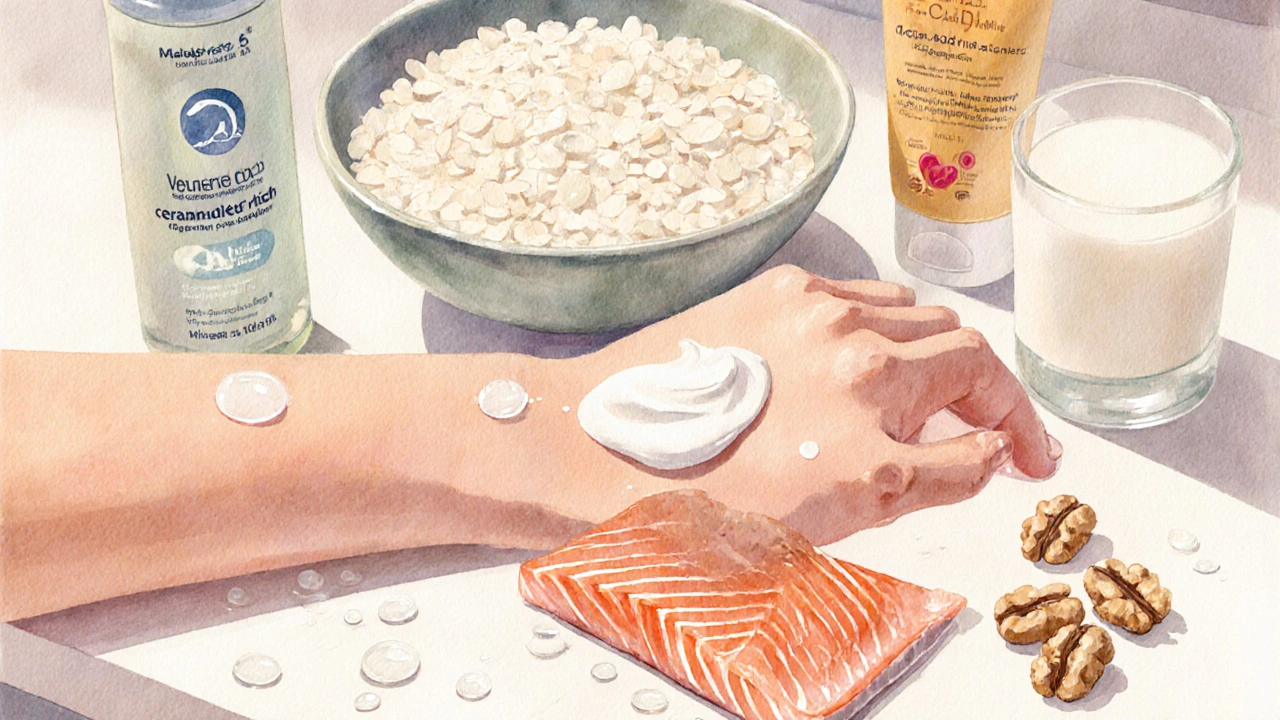How to Manage Skin Inflammation During Seasonal Changes - A Practical Guide

Key Takeaways
- Identify the seasonal triggers that aggravate skin inflammation.
- Keep the skin barrier strong with proper moisturizing and gentle cleansing.
- Support your skin from inside with anti‑inflammatory foods and adequate hydration.
- Use targeted over‑the‑counter or prescription options when needed.
- Know the red‑flag symptoms that require a dermatologist’s attention.
When the weather flips, many of us notice our skin reacting - redness, itching, a burning sensation, or flaky patches appear out of nowhere. Those signs are often the result of skin inflammation is the body's response to irritation, allergens, or changes in temperature and humidity that cause redness, swelling, and discomfort in the skin. If you’ve ever blamed a dry winter or a humid spring for a flare‑up, you’re not alone. This guide shows you how to manage skin inflammation effectively throughout the year, with practical steps you can start today.
What Causes Seasonal Skin Inflammation?
Seasonal changes affect the skin in three main ways: temperature swings, humidity levels, and environmental allergens. Each season brings its own cocktail of triggers.
- Winter: Cold air and indoor heating strip natural oils, leaving the skin dry and prone to cracks.
- Spring: Pollen and mold spores act as allergens that can ignite eczema or dermatitis.
- Summer: UV radiation, sweat, and chlorine weaken the barrier, especially for sensitive skin.
- Fall: Rapid humidity drops can cause a “shock” to the skin, prompting flare‑ups.
People with pre‑existing conditions such as eczema (a chronic inflammatory skin condition characterized by itchy, red, and dry patches or psoriasis (an autoimmune disease that speeds up skin cell turnover, leading to thick, scaly plaques) are especially sensitive to these shifts.
Core Strategies to Keep Inflammation in Check
Think of your skin like a house. When the weather changes, you reinforce the walls, fix any leaks, and adjust the thermostat. The same logic applies to skin care.
1. Hydrate and Moisturize
Moisturizers lock in water and restore the lipid barrier. Look for ingredients that mimic the skin’s natural fats.
- Ceramides: These are the building blocks of the barrier. A ceramide (a family of lipid molecules that help retain moisture and protect against irritants-rich cream works well in winter and dry indoor environments.
- Hyaluronic Acid: Pulls water from the air into the skin; best for humid climates.
- Petroleum Jelly: An occlusive that seals in moisture; great for nighttime “lock‑in” especially in cold months.
Apply moisturizer within three minutes of cleansing while the skin is still damp - that’s when it absorbs best.
2. Choose a Gentle Cleanser
A harsh soap can strip the barrier and trigger inflammation. Switch to a pH‑balanced, fragrance‑free cleanser that cleans without over‑drying. Avoid sulfates and alcohol.
3. Reinforce the Barrier with Topical Treatments
When flare‑ups occur, short‑term use of topical corticosteroids (medicated creams that reduce inflammation and itching by suppressing immune responses in the skin can calm the area. Use the lowest potency that works and follow a doctor’s guidance to prevent thinning.
4. Support from the Inside - Anti‑Inflammatory Diet
What you eat influences skin health. Incorporate foods rich in omega‑3 fatty acids (essential fats found in fish, flaxseed, and walnuts that reduce systemic inflammation. Aim for two servings of fatty fish a week or add a tablespoon of ground flaxseed to smoothies.
- Probiotic‑rich foods (yogurt, kefir, sauerkraut) help balance gut bacteria, which can affect skin immunity.
- Limit processed sugars and dairy if you notice a direct link to flare‑ups.
5. Protect Against External Irritants
Use sunscreen daily, even on cloudy days, to guard against UV‑driven inflammation. Choose a mineral sunscreen with zinc oxide or titanium dioxide if your skin is extra sensitive.

DIY Soothers for Quick Relief
Sometimes you need an instant calm. These kitchen‑based recipes are safe, inexpensive, and can be stored for a few weeks.
- Oatmeal Bath: Add one cup of colloidal oatmeal to lukewarm bath water. Soak for 15 minutes to soothe itching.
- Aloe Vera Gel: Apply pure gel directly to red patches. It hydrates and has anti‑inflammatory properties.
- Chamomile Compress: Brew a strong chamomile tea, chill, and place a soaked cloth on affected skin for 10 minutes.
Always patch‑test a small area first to ensure you don’t react to any new ingredient.
When to Call a Dermatologist
Home care works for most mild to moderate flare‑ups, but watch for these warning signs:
- Blisters, oozing, or crusting that doesn’t improve in a week.
- Severe pain or spreading redness beyond the original patch.
- Fever, joint pain, or other systemic symptoms.
- Persistent itching that disrupts sleep.
Professional evaluation can pinpoint underlying causes, prescribe stronger medications, or suggest phototherapy if needed.
Season‑Specific Quick Checklist
- Winter: Switch to a richer ceramide moisturizer, use a humidifier, limit hot showers.
- Spring: Keep windows closed during high pollen days, rinse skin after outdoor activities, add antihistamine eye drops if eyes itch.
- Summer: Apply mineral sunscreen every 2 hours, shower after sweating, use lightweight, non‑comedogenic moisturizers.
- Fall: Re‑introduce gentle exfoliation to remove dead skin, moisturize immediately after washing, stay hydrated.
Comparison of Popular Over‑the‑Counter Moisturizers
| Product | Key Ingredient | Best Season | Price Range (USD) |
|---|---|---|---|
| Cerave Moisturizing Cream | Ceramides & Hyaluronic Acid | Winter & Dry Indoor | $12‑$15 (30ml) |
| Neutrogena Hydro Boost Gel‑Cream | Hyaluronic Acid | Summer & Humid Climates | $18‑$22 (50ml) |
| Eucerin Advanced Repair Lotion | Urea & Ceramides | All‑Season (especially Fall) | $13‑$16 (340g) |
| Vaseline Petroleum Jelly | Petroleum | Night‑time Seal (All Seasons) | $5‑$8 (454g) |
Frequently Asked Questions
Can I use the same moisturizer year‑round?
You can, but a moisturizer formulated for winter (rich in ceramides) may feel heavy in summer, while a lightweight gel can leave a thin‑skinned winter‑prone person feeling dry. Switching seasonally gives your skin the right balance of hydration and breathability.
What’s the difference between eczema and psoriasis?
Eczema (atopic dermatitis) usually starts in childhood, is intensely itchy, and is triggered by allergens or irritants. Psoriasis is an autoimmune condition that creates thick, silvery scales and is less linked to external allergens. Both involve inflammation, but their treatments differ.
Are there any natural supplements that actually help?
Clinical studies support omega‑3 fish oil (EPA/DHA) for reducing skin inflammation, and probiotics for improving the gut‑skin axis. A daily dose of 1,000mg EPA + DHA and 10billion CFU of a multi‑strain probiotic is a common recommendation.
How often should I apply a topical steroid?
Typically, a thin layer is applied once or twice daily for up to two weeks, then tapered. Overuse can thin the skin, so always follow a dermatologist’s schedule.
Is humidifier use really necessary?
Yes. Maintaining indoor humidity around 40‑50% helps keep the skin barrier from drying out, especially in heated homes during winter.



Raghav Suri
First off, you’ve nailed the basics – moisturizing right after a wash is non‑negotiable. Ceramides and hyaluronic acid are the dynamic duo; slap them on while the skin’s still damp and you’ll lock in moisture like a vault. If you’re heating your home, a humidifier set to 45 % can prevent that itchy “winter‑skin” feel. And don’t underestimate the power of a gentle, sulfate‑free cleanser – it’s the first line of defense against barrier breakdown. Finally, keep an eye on any red‑flag symptoms; early intervention saves you weeks of misery.
Susan Cobb
While the article offers a decent primer, it somewhat glosses over the nuance of barrier repair. One must appreciate that not all ceramide‑rich creams are created equal; the molecular weight matters, and many over‑the‑counter options are merely emollient masquerading as actives. Moreover, the recommendation to “apply within three minutes” feels like marketing fluff; the skin’s actual uptake window can extend up to fifteen minutes under optimal conditions. In my experience, a layered approach – starting with a lightweight serum followed by an occlusive at night – yields superior results. The guide also neglects the role of sphingolipid‑based formulations, which are emerging as true game‑changers in dermatologic science.
Kelly Hale
As someone who has seen my fair skin battered by the unforgiving monsoons and scorching summers of our homeland, I can attest that the guide barely scratches the surface of what our climate demands. The blanket advice about ceramides and hyaluronic acid, while useful, fails to acknowledge the harsh UV index that our region consistently records in double digits, forcing us to double‑down on mineral sunscreens. Moreover, the recommendation to use petroleum jelly at night seems almost reckless when night‑time humidity dips below ten percent, turning our pores into an open desert. We need to incorporate antioxidant‑rich serums, such as those infused with green tea catechins, to combat oxidative stress that our skin endures daily. The section on dietary omega‑3s is commendable, yet it omits the potency of locally sourced flaxseed oils that are more accessible and equally effective. Our cultural practices also dictate that we wash our faces multiple times a day with harsh soaps, a habit that strips the barrier faster than any winter wind. This habit must be curtailed; a simple, fragrance‑free cleanser with a pH of 5.5 can preserve the skin’s innate flora. When the article mentions “short‑term use of topical steroids,” it glosses over the potential for rebound flare‑ups, especially in people prone to eczema, which is endemic among our population. The guide should stress tapering schedules and the use of steroid‑sparing agents like tacrolimus. Additionally, the emphasis on “humidifiers” during winter is a luxury many cannot afford; we must explore affordable alternatives like placing a bowl of water near heating vents. The DIY recipes, though charming, need reinforcement that raw aloe vera can sometimes harbor aloin, a potent irritant, unless it is properly filtered. Lastly, the red‑flag symptoms list is spot‑on, but could be expanded to include persistent itching that leads to excoriation, a common plight in our community. In sum, while the guide serves as a starting point, it requires a more aggressive, localized strategy to truly safeguard our skin against the relentless seasonal onslaught. Implementing community workshops on proper skin care can bridge the knowledge gap. Only with such comprehensive measures can we hope to tame the seasonal demons that plague our skin.
Uju Okonkwo
Great points, Raghav! I’d add that a simple daily routine of gentle cleansing followed by a ceramide‑rich cream can make a world of difference, especially for those with sensitive skin. Also, consider sprinkling a few drops of rosehip oil into your night moisturizer for an extra boost of skin‑repairing fatty acids.
allen doroteo
Thats not always true.
Corey Jost
I completely agree with Uju’s suggestion, and I’d like to expand on the notion of layering actives for optimal barrier support. First, you must recognize that the skin’s pH fluctuates throughout the day, so applying a low‑pH serum in the morning followed by a higher‑pH moisturizer in the evening can enhance product synergy. Second, the inclusion of niacinamide creates a bridge between barrier reinforcement and inflammation control, making it a versatile addition to any seasonal regimen. Third, don’t forget to patch‑test any new ingredient, particularly when transitioning between winter and spring, where allergens like pollen can exacerbate reactions. Fourth, a brief 5‑minute facial massage can stimulate lymphatic drainage, aiding in the removal of inflammatory mediators. Finally, consistency is key; even the most sophisticated routine will fail without regular adherence. By integrating these principles, you’ll find that seasonal flare‑ups become far less daunting.